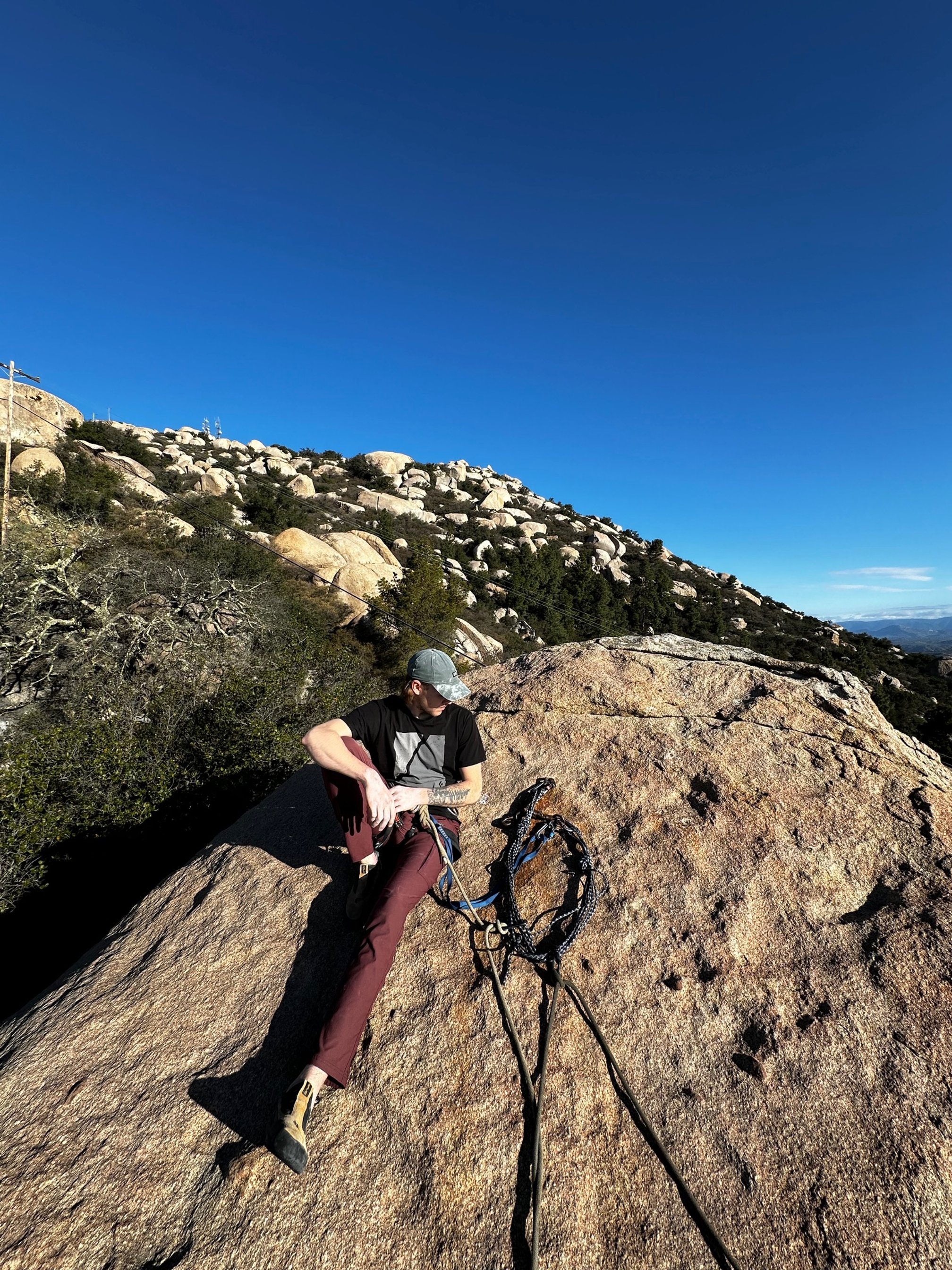This month we have an unreported accident from a few years ago. This incident occurred at Mt. Woodson near San Diego. A climber atop one of beautiful granite boulders that sprinkle the area was lowering his partner when the unthinkable occurred.
Thibault Philippine leads the mega classic Robbins Crack (5.10a) at Mt. Woodson. This boulder was the scene of a serious lowering accident in 2021. Visible in this image is the sloping summit and the barely discernible anchor bolts, six feet below and to the right of the top. Note: Philippine was not in any way involved in this accident. Photo: Philipp Arndt
Ground Fall | No Belay Anchor
San Diego County, Mt. Woodson
On February 24, 2021, Dawson Riley (21) and his friend (19) were enjoying a day out at Mt. Woodson. Riley, an experienced climber, had taken this friend climbing a few times before. Riley first led the 35-foot route Robbins Crack (5.10a) and attached a quad anchor sling to the bolts atop the large boulder. His friend then followed, with Riley belaying from above on a Grigri. Riley then adjusted the position of the anchor so that they could lower each other and climb Lie Detector (5.12a/b), another crack route (the analog to Robbins Crack) that shares the same bolt anchor. After each climber took a turn on Lie Detector, they sat together on top of the boulder.
Shortly after, Riley removed his quad anchor from the bolts. Unanchored and with the Grigri clipped directly to his harness, Riley began lowering his friend down the Robbins Crack side of the boulder. The rope began feeding rapidly through the Grigri. Riley released the brake handle to block the rope and started to slide off the boulder. Riley fanned out his body in an attempt to increase friction but was quickly launched off the boulder. He fell approximately 25 feet and landed on his right side. His partner, still tied to the end of the rope, had fallen approximately ten feet and was uninjured.
On impact, Riley suffered a seizure and remained unconscious. Others nearby heard his partner yelling for help. They called 911, and nearby CAL FIRE first responders arrived. They placed Riley on a stretcher and onto the flat bed of their truck, then transported him to a nearby airport. There, they met a Mercy Air medical helicopter, who flew him to the Palomar Health trauma center.
Riley sustained multiple injuries including a concussion, an open fracture of both bones in the right forearm, a lung contusion, and three pelvic fractures. He was not wearing a helmet. He required multiple surgeries but has fully recovered and continues to climb.
Dawson Riley sitting atop the Robbins Boulder last week. He has fully recovered from the 2021 accident. As you can see, this time Riley is safely attached to the anchor bolts. Photo: Alex Sanson
Analysis
The Robbins Boulder requires lowering or rappelling to descend. The large and deceptively angled summit can give climbers a false sense of security. Dawson recalled having removed his quad anchor from the bolts while he and his friend sat and relaxed after climbing Lie Detector. The quad anchor gear remained attached to his harness, while his friend remained tied into the rope.
Complacency plays a role in many accidents, and this incident might be no exception. In this case, Riley’s familiarity with the climb (he’d been on top of the Robbins Boulder many times) and the large, comfortable summit belied the hazard. In any perilous position, it is critical to establish and maintain a safe anchor, perform safety checks with your partner, and assess/test the system before detaching from the anchor. It is also wise to redirect the rope through the anchor while lowering another climber from a braking device that is directly attached to the harness. This technique creates extra friction and allows more control of the lowering speed and the force on the belayer.
A safer alternative might have been a rappel from the bolts. As Riley recalls, “Looking back, the only way I had descended the route [previously] was by rappelling. On that day, my brain wanted to lower my partner because I noticed he was still tied in and the rope was running through my Grigri. But muscle memory was getting me ready to rappel, so I removed the quad then began lowering without registering that I was unanchored.”
(Source: Dawson Riley.)
Learn More About Safe Lowering Techniques
John Godino at Alpine Savvy has created climbing and navigation content for years. Below are some good tips on lowering at alpinesavvy.com.
Sign Up for AAC Emails
“The Prescription” is the monthly newsletter of Accidents in North American Climbing. Join the American Alpine Club email list to get it right to your inbox.




